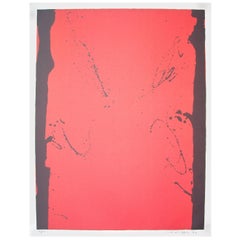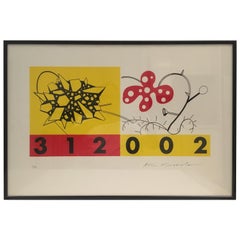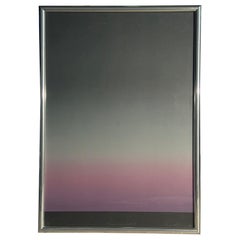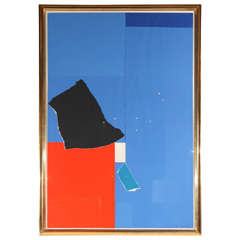Emerson Woelffer Contemporary Art
American, 1914-2003
Once dubbed “the Grandfather of L.A. Modernism,” the Chicago-born Emerson Seville Woelffer was active as an innovative painter, collagist, and educator throughout his long and prolific career. A pioneering Abstract Expressionist, Woelffer’s brightly colored work with jagged forms reveals Cubist and Surrealist influences.
Coming of age in Chicago during the Great Depression, Woelffer appreciated the improvisational nature of jazz music, a sensibility he would later apply to painting through gestural variation, energetic strokes, and a rhythmic use of line. From 1935 to 1938, Woelffer, a high school dropout, studied at the Art Institute of Chicago while employed as a janitor, early evidence of his enduring work ethic.
He joined the Works Progress Administration arts program in 1938 as an easel painter, followed by a two-year stint as a topographical draftsman for the United States Air Force. The director of the Chicago Institute of Design, László Moholy-Nagy, invited Woelffer to join the faculty in 1942. His experiences there brought him into contact with the modernist idiom of the day, and his interactions with students caused him to re-examine his own practice.
He also exhibited in group shows at the Guggenheim Museum in New York, participated in the Whitney Museum Annual (1949) and won the Pauline Palmer Prize for painting at the Art Institute of Chicago (1948).
In 1949 Emerson Woelffer and his wife Dina, a fine art photographer, were invited by Jackson Pollock and Lee Krasner to New York before they headed to Mexico’s Yucatán Peninsula. Exposure to Pre-Columbian art led Woelffer to incorporate totemic figures and vibrant colors into his abstract paintings.
In 1959 Woelffer joined the faculty at the Chouinard Art Institute (later the California Institute of the Arts) in Los Angeles, where he instructed notable emerging artists until 1973 and where he was instrumental in bringing Modernism to LA. Ed Ruscha was one of his students. In 1974, Woelffer was named chair of the art department at the Otis Art Institute (now the Otis School of Art and Design). His tenure lasted until his retirement in 1989, and he was widely admired for his interdisciplinary approach in the classroom. An endowed scholarship fund in his name provides support for promising young artists and designers. Suffering from macular degeneration, Woelffer switched to drawing with white crayon on black paper in his final years of artistic activity.
Emerson won a prestigious Guggenheim Foundation Fellowship in 1967 and then went to wprk in Europe. Woelffer’s work is represented in the collections of such distinguished institutions as the Smithsonian American Art Museum, the National Gallery of Art, and the Museum of Modern Art, among others.to
1
1
Height
to
Width
to
1
1
1
1
1
1
1
1
1
1
10
126
67
37
34
Creator: Emerson Woelffer
Emerson Woelffer Lithograph, 50/50 Signed, Dated, Unframed, Modern 74
By Emerson Woelffer
Located in Los Angeles, CA
Nice lithograph, of the well-known modernist artist Emerson Woelffer. Signed, numbered 50/50. Dated 74.
Category
1970s American Modern Vintage Emerson Woelffer Contemporary Art
Materials
Paper
Related Items
Mid Century Modern Abstract Art Lithograph Signed Aki Kimoto
Located in Miami, FL
Original modern art lithograph by Japanese artist Aki Kimoto. This colorful piece bears an original signature and is number 12/150 of the limited edition. Combining cubic images as w...
Category
21st Century and Contemporary Japanese Emerson Woelffer Contemporary Art
Materials
Paper
$360 Sale Price
20% Off
H 19.1 in W 27.76 in D 0.1 in
Gary Lichtenstein “Seems Like Manhattan 2” Signed Lithograph #7/30
Located in Miami, FL
Original signed lithograph Seems Like Manhattan II by Gary Lichtenstein. Signed and numbered 7/30.
Two additional Seems Like Manhattan lithographs...
Category
21st Century and Contemporary American Modern Emerson Woelffer Contemporary Art
Materials
Glass, Paper
Contemporary Art Painting, Dated and Signed "LM 91"
Located in Aalsgaarde, DK
Contemporary art painting, dated and signed "LM 91"
Measures: H. 84 W. 63 cm
H. 33 W. 24.8 in.
Category
1990s European Mid-Century Modern Emerson Woelffer Contemporary Art
Curtis Jere Peacock / Swan Wall Sculpture, Signed and Dated 1987, Brass Finish
By Curtis Jeré
Located in Kansas City, MO
Large Curtis Jere wall sculpture of a peacock / swan. Completely original in very good to excellent condition metal sculpture with a brass finish and applied patina creating the dark...
Category
1980s American Modern Vintage Emerson Woelffer Contemporary Art
Materials
Metal
$2,950
H 39 in W 58 in D 3.5 in
Hernández Pijoan Untitled, Signed an Dated 1971
Located in Saint-Ouen, FR
Hernández Pijoan (1931-2005) untitled
Gouache and pencil on paper.
Signed an dated 1971.
Category
1970s Spanish Vintage Emerson Woelffer Contemporary Art
Materials
Paint
Contemporary Signed Very Colorful Abstract Lithograph
Located in Philadelphia, PA
Contemporary Signed Very Colorful Abstract (2 of 15) Lithograph - 1997
Frame and matting needs to be updated.
Category
1990s American Modern Emerson Woelffer Contemporary Art
Materials
Paper
$158 Sale Price
60% Off
H 36 in W 29.5 in D 0.75 in
Mihail Chemiakin Color Lithograph Signed
By Mihail Chemiakin
Located in Miami, FL
A fine lithograph by Mihail Chemiakin, signed and numbered in pencil
Professionally framed.
Artist: Mihail Chemiakin, Russian (1943 - )
Title unknown
Year: Circa 1980
Framed size:...
Category
20th Century French Emerson Woelffer Contemporary Art
Materials
Paper
Mihail Chemiakin Color Lithograph Signed
By Mihail Chemiakin
Located in Miami, FL
A fine color lithograph by Mihail Chemiakin, signed and numbered in pencil.
Professionally framed.
Artist: Mihail Chemiakin, Russian (1943 - )
Title unknown
Year: Circa 1980
Frame...
Category
20th Century French Emerson Woelffer Contemporary Art
Materials
Paper
"Landscape", 1972, Watercolor, Signed and Dated, Martínez Novillo, Cirilo
By Cirilo Martínez Novillo
Located in Madrid, ES
Martínez Novillo, Cirilo (Madrid, 1921-2008).
"Landscape", 1972.
Watercolor. Signed and dated in the lower right corner.
Cirilo Martínez Novillo is one of the most outstanding ...
Category
1970s Spanish Other Vintage Emerson Woelffer Contemporary Art
Materials
Other
$2,358
H 11.82 in W 9.45 in D 3.94 in
Gary Lichtenstein “Seems Like Manhattan” Signed Lithograph #7/50
Located in Miami, FL
Original signed lithograph Seems Like Manhattan by Gary Lichtenstein. Signed and numbered 7/50.
Two additional Seems Like Manhattan lithographs ...
Category
21st Century and Contemporary American Modern Emerson Woelffer Contemporary Art
Materials
Glass, Paper
Lithograph by Waykeri Rawlinson, Hand Signed
Located in Miami, FL
A very decorative, original lithograph.
Hand signed in pencil.
Numbered 46/280
Underneath the signature appears that the name of the artist printed on the paper: Waykeri Rawlinson. ...
Category
20th Century American Modern Emerson Woelffer Contemporary Art
Materials
Paper
"Lilies" Signed and Dated Serigraph by Donald Sultan
By Donald Sultan
Located in Stamford, CT
"Lilies" signed and dated serigraph by Donald Sultan (American b. 1951). # 35/70.
Category
1990s North American Modern Emerson Woelffer Contemporary Art
Materials
Paper
Previously Available Items
Original, 1979 Paper Collage
By Emerson Woelffer
Located in Los Angeles, CA
Signed and dated, original collage by American artist, Emerson Woelffer.
Category
1970s American Vintage Emerson Woelffer Contemporary Art
Emerson Woelffer contemporary art for sale on 1stDibs.
Emerson Woelffer contemporary art are available for sale on 1stDibs. These distinctive items are frequently made of paper and are designed with extraordinary care. There are many options to choose from in our collection of Emerson Woelffer contemporary art, although pink editions of this piece are particularly popular. Many of the original contemporary art by Emerson Woelffer were created in the modern style in united states during the 1970s. If you’re looking for additional options, many customers also consider contemporary art by Keith Haring, John Dugdale, and Henry Moore. Prices for Emerson Woelffer contemporary art can differ depending upon size, time period and other attributes — on 1stDibs, these items begin at $1,600 and can go as high as $1,600, while a piece like these, on average, fetch $1,600.



